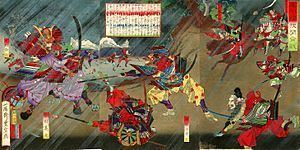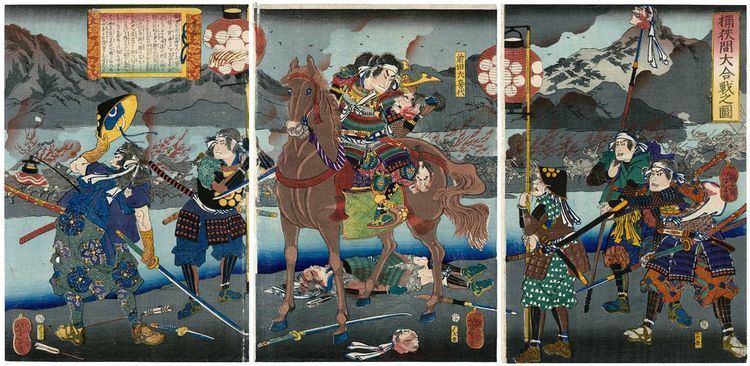25,000 ~2,000-3,000 | Period May 1560 – June 1560 | |
Results Decisive Oda Victory, (Imagawa killed in action) Similar Battle of Nagashino, Honnō‑ji incident, Battle of Sekigahara, Battle of Anegawa, Battles of Kawanakajima | ||
Warring states japan sengoku jidai i battle of okehazama extra history
The Battle of Okehazama (桶狭間の戦い, Okehazama-no-tatakai) took place in June 1560. In this battle, Oda Nobunaga defeated Imagawa Yoshimoto and established himself as one of the front-running warlords in the Sengoku period.
Contents
- Warring states japan sengoku jidai i battle of okehazama extra history
- Samurai warriors 4 ps4 legend of the oda battle of okehazama
- Background
- Battle
- Aftermath
- Legacy
- References
Samurai warriors 4 ps4 legend of the oda battle of okehazama
Background
In June 1560, Imagawa Yoshimoto, with an army of about 25,000 men, set forth on a march to Kyoto. Entering the Oda territories in Owari Province, he first took the border fortresses of Washizu and Marune before setting up camp in a wooded gorge known as Dengaku-hazama. This was all reported to Oda Nobunaga by his scouts and, in response, Nobunaga then led his own forces into position at a temple called Zenshō-ji, a short distance away, on the other side of the Tōkaidō (road).

Had Nobunaga decided on a frontal assault, the battle would have most likely been lost, as his army was heavily outnumbered by the Imagawa forces. A frontal assault would have resulted in defeat and an attempt to hold out at Zenshō-ji would have only lasted a few days. Because the odds were against their side, some of Nobunaga's advisers suggested "to stand a siege at Kiyosu". Nobunaga refused, stating that "only a strong offensive policy could make up for the superior numbers of the enemy, and calmly ordered a counterattack."
Battle

Oda left a dummy army at Zenshō-ji with a large number of banners, to give the impression that this was the location of his main force. Meanwhile, Oda's main force (between 2,000 to 3,000 men) moved through the forest undetected to the rear of the Imagawa army at Dengaku-hazama from the north.

The Imagawa samurai did not expect an attack, and that afternoon was very hot. The Imagawa were celebrating their recent victories at Dengakuhazama. An afternoon thunderstorm further shielded Oda's soldiers' advance.
When the storm passed, Oda's men poured into the camp from the north, and the Imagawa warriors lost all discipline and fled from the attackers. This left their commander's tent undefended, and the Oda warriors closed in rapidly. Imagawa Yoshimoto, unaware of what had transpired, heard the noise and emerged from his tent shouting at his men to quit their drunken revelry and return to their posts. By the time he realized, moments later, that the samurai before him were not his own, it was too late to organize a defense. Yoshimoto was attacked by Mōri Shinsuke and Hattori Koheita. Yoshimoto engaged them in melee, and parried their initial attack, but was soon overcome and killed.
Aftermath
With their leader dead, and all but two of the senior officers killed, the remaining Imagawa officers joined Oda's army.
Soon the Imagawa faction was no more and Oda Nobunaga was "in the front rank of military power". The most important of the samurai lords who joined Oda after this battle was Matsudaira Motoyasu from Mikawa Province. Matsudaira later took the name Tokugawa Ieyasu, and would remain a loyal ally until Nobunaga's death.
Legacy
In 1937, Japan's Ministry of Education designated the battlefield, Okehazama Kosenjo, a national historical site. Located at Minamiyakata, Sakae-cho, Toyoake City, the site hosts The Shichikokuhyo, or Seven Granite Pillars, with each pillar representing Yoshimoto's seven warlords. The first of the pillars bears the words, "Imagawa Yoshimoto was killed here."
The battlefield is now a park.
